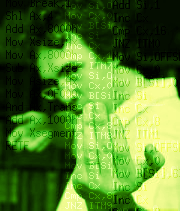Je dois reconnaître que celle-là je ne m'y attendais pas, mais figurez-vous qu'une équipe s'est mise en tête de nous faire une reprise de
Fury of the Furries! Eh oui. J'en veux pour preuve
une vidéo "playthrough" du nouveau château. Bon, je suivais à distance le projet depuis un moment, et je ne peux évidemment pas m'empècher (après Giana et Bubsy) de juger "ce qui marche et ce qui ne marche pas" dans cette adaptation.
Tout bon: le pixel art. Sur les décors principalement, bien que les sprites ne soient pas en reste. Les graphistes semblent avoir bien capturé le côté "di-chromie" du premier opus et s'en servent judicieusement (mur du fond dans les tons mauves et boiseries qui ressortent bien) ainsi que les "textures" variées des briques et autres éléments de décors.
A améliorer: la bande son. N'allez pas me faire dire que l'artiste en charge ne fait pas de belles choses, mais sincèrement, comparé au travail d'El Mobo sur l'original (remixé?), on se sent loin du compte. Ça manque de punch et de personnalité. J'aurais presque envie de dire à CJ "allez, je leur laisse Pikaboo Castle" (mais il est déjà dans Wolfling ^^")
Know what? One of the authors of the original Fury of the Furries game has started an indie Furry 2 project! From times to times, we get videos of in-progress game development - and recently, that was a full playthrough video of one of the environments: the castle. Great pixel art, improvable soundtrack and a mood that feels like keeping the genome of the original game. Let's see whether we can say more about game design...

Interpellant: la longueur des niveaux. Fury, c'était un 'puzzle platformer'. Pas que la dimension "casse-tête" soit majoritaire comme dans un "Toki Tori", mais enchaînant des niveaux plutôt courts les uns derrière les autres. ça donne la possibilité de se concentrer sur l'exploration/l'observation d'un des niveaux pour trouver les mécanismes à activer, les passages secrets, etc. Ici, on a une map plutôt grande concentrant tout ce qu'il y a a dire (?) sur le chateau, et dans laquelle on nous invite à trouver un bon millier de fruits et légumes cachés. Pas loin de 40 minutes pour une exploration exhaustive sans respawn, c'est long, comme session de jeu.
Levels are much *much* longer than in the original puzzle-platformer game. That somehow make sense since the 'puzzle' part seems to have been dropped in favour of a more regular "explore-platformer with some local puzzles to get extra things". When you're designing a puzzle, you want to expose as much of the items to your player's eyes, so they brains can solve the puzzle instead of trying to remember what they've seen elsewhere. You also need to ensure failing the puzzle (which often implies dying or retrying from the start in the original game) won't ask your player to redo too much again, and short levels help on that. Still, here we've got about 40 minutes of video for a collect-all-items playthrough.
Mitigé: les pouvoirs. Fury, c'est 4 pouvoirs différents et (le plus souvent), la possibilité de passer de l'un à l'autre. Jaune = attaque, Rouge = mange-mur, bleu = nageur, vert = acrobate à la corde ninja. Le principe est conservé ici, bien que si je ne me trompe pas, il est maintenant possible de changer de pouvoir instantanément, sans attendre d'avoir mis son personnage à l'arrêt (ce dont je ne me plaindrai probablement pas). J'avoue que le côté " vert se balance avec sa langue" a un côté dégueu-kid-paddle dont je me serais passé, mais je suis prêt à le concéder comme liberté artistique des nouveaux (?) auteurs au même titre que je passe l'éponge sur l'exagération graphique de Rayman Origins/Legends.

Bleu peut maintenant cracher de l'eau, ce qui donne lieu à quelques interactions sympas (je ne vais pas appeler ça des puzzles) comme ici avec un canon qui perd toute sa vigueur si on noie sa mèche. Il faut toujours Jaune et ses kameah pour se débarasser de la plupart des ennemis, donc ça reste équilibré et ça atténue un peu l'effet "Bleu ne sert à rien, y'a pas d'eau" du jeu original.
Rouge a maintenant la possibilité de voler en pétant. C'est kid qui va être ravi. La mécanique est rigolote, le contrôle en vol plutôt correctement dosé (à vérifier manette en main) entre trop fort et pénible-à-la-Donkey-sur-un-tonneau-fusée, l'habillage (comprenez les prouts) bien en phase avec le personnage (dévore tout et n'importe quoi) et la fonction (mon filleul parlait déjà des prouts de Yoshi pour justifier sa faculté à voler un petit moment dans Yoshi's Island). J'ai un peu peur que ça ne rende les acrobaties de Vert fort anecdotiques, par contre. Pourquoi se prendre la tête à faire le ninja quand on peut léviter ?
The general idea of 4 characters with different abilities and a way to swap between them (you only ever control one avatar) has been kept and the overall ability scheme has been preserved: Yellow shoots, Red eats, Green swing and Blue swims. Well, Blue can also exhale water (solves some puzzles, and used as a weak weapon). And green can slurp bonuses at a distance (possibly swallow small baddies ?). The most modified one is Red. He can now fart-fly for significant distances. To what extent will that break platforming or rope-swinging, I'm unsure of. I understand this won't disappear because it was the core gameplay of a mobile game I've never played. It doesn't look very balanced on the video, but maybe that's because player has already collected some fart-more-power-ups or something similar (I see hints that Yellow has now limited shots despite the counter never goes down, either). Anyway, since there are already portals that forbid the use of one character for one area, there's a clear way to enforce player would use rope-swinging or jumping in some specific room if level designer decides so.

Enfin, et c'est sans doute lié au passage du puzzle à une approche plus "collect-platformer", les retraits de pouvoirs semblent plutôt rares. Le jeu d'origine nous mettait souvent dans un niveau avec seulement 2 pouvoirs, et un 3eme à réactiver dans une zone précise. Ici, c'est plutôt "les 4 font la fête" en permanence avec quelques passages "Regarde Maman! Sans les mains!" pour l'une ou l'autre salle bonus.
Très bien: le côté décalé. On a gardé les loups-garous qui se changent en lapinou, les parodies de Dracula, les clins d'oeil aux flippeurs et compagnie. Trop tôt pour dire si les cameos seront aussi nombreux que dans l'original (en particulier dans le niveau final. On dirait bien), mais on a ni renié ses origines façon préhistorik-supernes, ni sombré dans un excès qui perd toute saveur façon film de Jim Carrey.
A tester: la barre de vie. Fury était un die-and-retry. Tout comme Commander Keen et Rick Dangerous, tout contact y était fatal. C'était précieux pour certains puzzles mais ça pouvait devenir franchement gonflant quand le moindre pet de mouche dans la tronche vous éclate. Là, avec 6 points de vie en début de niveau et des ennemis qui explosent au moindre tir (le jeu d'origine vous demandait régulièrement de bourrinner le bouton de tir 5 à 10 secondes pour la moindre araignée) et distribuent généreusement des petits coeurs, j'aurais du mal à fixer un pronostic.
One last item that might be worth tuning is the amount of hitpoints for both baddies and furries. The original game had a die-and-retry aspect for the player while any baddies would require numerous shots to be defeated. Here this is the opposite: plenty of hitpoints for the player and most ennemies explode in one shot, often releasing a heart for the player to recover. I know I've been wondering whether some god mode was enabled while watching the video. But it wouldn't be too hard to make that customizable by the player, adjusting heart-drop-probabilities or baddies resistance to Yellow's shots through menu or collectibles. Don't let that prevent you from wishlisting the game!
Bref, vous l'aurez compris: Fury 2 n'est pas un remake de Fury 1, mais il reste fidèle à l'esprit et à l'ambiance de l'original. J'aurais envie de comparer l'évolution de gameplay à ce que l'on a pu voir entre Ori 1 et Ori 2. Je souhaite une bonne finalisation au projet et un grand merci au Cyrille qui bosse là-dessus de nous proposer un retour en Furries. Wishlistez bien ^_^








 Vote for your favourite post
Vote for your favourite post

